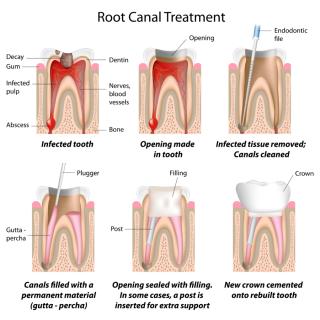There are tiny canals within your tooth that may become infected. This leads to the pulp inside your tooth also becoming infected as well. Either your dentist or an endodontist to remove any infection performs the root canal procedure. The canals are cleaned and then filled and the tooth receives either a filling or a crown.
Depending on the number of teeth and severity affected, root canals usually require one to two visits not including any follow-up visits. Your dentist or Endodontist will numb the area around the affected tooth, or may offer you the option of mild sedation. A rubber dental dam is placed and the tooth is then drilled to the pulp area either through the top or the back of the tooth. The actual root canals are measured after some of the pulp has been removed. This is done so that our Doctors of Anderson Dental can clean the entire canal, and so that enough of the filling material will be used to completely fill the canal. The actual measuring is done with either x-rays or electronic imaging devices.
All of the diseased pulp in the tooth is removed, and the canal is cleaned out thoroughly with an antiseptic solution. This solution will clean all of the canals within the tooth. The canals are then filled with gutta percha, a flexible plastic material. A temporary filling is then put on top of that. A crown or permanent filling will be done after there has been no sign of infection. Crowns are most common since the root canal procedure weakens the tooth. The crown is usually placed as soon as possible, within a month or less.
Expect two to three days of soreness after the procedure, or longer if the infection in the root canal was severe.
